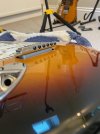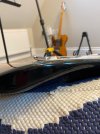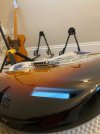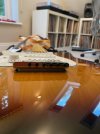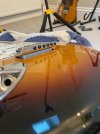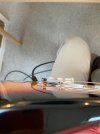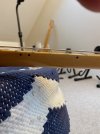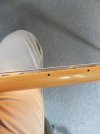Gilesy
Inspired
Hi all
I've just changed my strings on my US Strat Standard (25 years old and well looked after - every part original as manufactured). The guitar before restringing was super stable in tuning with a nice medium action. As per the photos, having changed to new set of 10s, the bridge looks as though it is 'leaning' (i.e. pivoting) too far forward under the tension of the new strings (normal tuning).
It's holding pitch fine with the new strings. I honestly can't be certain if the action is much worse, but subjectively it feels a little higher. But I simply cannot recall the bridge/trem looking like it does.
Is it possible that something has become unsettled when I removed all the old strings (I did them all at once rather than one by one)? Could the springs have given up providing the right resistance, but if this is the case why was this not apparent before I changed the strings? (of course it may have happened gradually over time as the springs aged, and I've just never noticed)
I would really value views on whether this a problem, or have i just never looked closely at the bridge when under tension before? if there are any fixes, please suggest (e.g. new springs) - and if so is there anything special I need to consider when replacing. I never use the trem.
Thank you in advance for your help.
Cheers, Gilesy
I've just changed my strings on my US Strat Standard (25 years old and well looked after - every part original as manufactured). The guitar before restringing was super stable in tuning with a nice medium action. As per the photos, having changed to new set of 10s, the bridge looks as though it is 'leaning' (i.e. pivoting) too far forward under the tension of the new strings (normal tuning).
It's holding pitch fine with the new strings. I honestly can't be certain if the action is much worse, but subjectively it feels a little higher. But I simply cannot recall the bridge/trem looking like it does.
Is it possible that something has become unsettled when I removed all the old strings (I did them all at once rather than one by one)? Could the springs have given up providing the right resistance, but if this is the case why was this not apparent before I changed the strings? (of course it may have happened gradually over time as the springs aged, and I've just never noticed)
I would really value views on whether this a problem, or have i just never looked closely at the bridge when under tension before? if there are any fixes, please suggest (e.g. new springs) - and if so is there anything special I need to consider when replacing. I never use the trem.
Thank you in advance for your help.
Cheers, Gilesy

